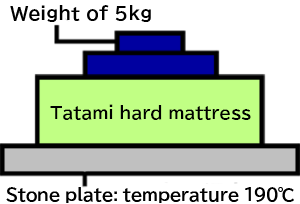Rush-grass and rice straw are both plants grown in rice fields.
They absorb and wick away moisture through their respiratory function and automatically adjust humidity.
They also have the ability to adsorb harmful gases inside a room and purify the air.
They have qualities that distinguish them from tatami mats made from artificial materials. The scent of fresh rush-grass has a calming effect.
 Cross section of a rush-grass
Cross section of a rush-grass
Properties of the hard tatami mattress
When it comes to tatami, what’s important is what’s inside. The hard mattress, which accounts for most of the thickness of the tatami, is the most important factor that determines all the qualities of the tatami mat.

Around 35,000 stems are used to make a hard mattress. The rice straw, carefully selected for each layer, is stacked by hand vertically and horizontally in several layers approximately 40 cm long, and compressed to approximately 5 cm by passing through a machine.
Rice straw has a hollow structure and can be used for several varieties of tatami.

Information provided by: Miyagi Prefectural Tatami Manufacturers Association
Moisture absorption and wicking properties
Cross section of rice straw showing hollow tissue structure.
It has an automatic humidity adjustment function that absorbs and releases moisture thanks to the respiratory function of natural materials.
It has a “natural air conditioner” function which absorbs approximately 3 liters of humidity per 11m2 room and releases it when the room dries out.

Elasticity
The resistance created by compressing 40 cm of rice straw into just 5 cm creates the elasticity and unique feel of this tatami, which is neither too soft nor too hard.
Result
Tatami is capable of supporting light objects gently and firmly supporting heavy objects.
The ability to relax while lying on the tatami is a unique advantage of rice straw tatami.

Information provided by: Miyagi Prefectural Tatami Manufacturers Association
Sound insulation (sound absorption effect)
It is generally said that sound insulation is proportional to weight.
This hard tatami mattress is made of tightly packed rice straw, so it has an excellent sound insulation effect that dampens the noises upstairs, footsteps, TV, stereo, etc.


Information provided by: Miyagi Prefectural Tatami Manufacturers Association
Heat retention/insulation

Cross section of a rice straw
The unique property of not allowing heat to pass through the mat and hollow structures of rice straw creates high thermal insulation..
Additionally, once warm, the straw acts as an insulator that prevents heat from escaping.
Experimentation
Stone panel size: 2.10 m x 2.10 m x 10 cm
To increase grip, a 5 kg steel weight is placed on top.
We placed a tatami mat at room temperature (31℃) on a stone plate heated to 190℃ and measured the time required for the tatami temperature to increase by 10℃.

Result
The real tatami took 14 minutes 10 seconds, and the building material tatami took 2 minutes 39 seconds.
This hard mattress of real natural tatami has approximately 5.3 times more insulation performance than that of building materials.
Information provided by: Miyagi Prefectural Tatami Manufacturers Association
Flame retardant properties
Although rice straw itself is flammable, the covering of the hard rice straw tatami mattress is compressed and treated to make it less flammable.
At room temperature, the fire burns and goes out.
In addition, as it is made from natural materials, unlike coatings using construction materials, it produces much less toxic gases in the event of a fire.

Information provided by: Miyagi Prefectural Tatami Manufacturers Association
Durability
It is made by compressing 40cm layers of rice straw to approximately one eighth, giving it excellent durability. The tatami can be replaced and repaired as many times as you want.
This is believed to be a rice straw tatami from the Edo period that was used in a certain temple in Kyoto until about 40 years ago. History proves its durability.

Health
In July 2003, building standards were revised to prevent health risks in buildings, and the use of VOCs and indoor concentration guideline values were defined. “Sick Building Syndrome” (SBM) caused by chemical components has decreased.
However, chemicals used everywhere cause considerable harm to health.
As a natural material that breathes, rice straw and rushes emit almost no harmful substances; in fact, they help improve the indoor air environment by absorbing them.


Information provided by: Miyagi Prefectural Tatami Manufacturers Association
Environment
Rice straw is recognized by the Japan Environmental Association as a recycled material that has virtually no impact on the environment and is produced in rice fields every year.
Our rice straw tatami is an Eco Mark certified product, respectful of people and the environment. This is a typical product that meets the needs of the SDGs, which must be implemented worldwide in response to global warming.

Information provided by: Miyagi Prefectural Tatami Manufacturers Association


